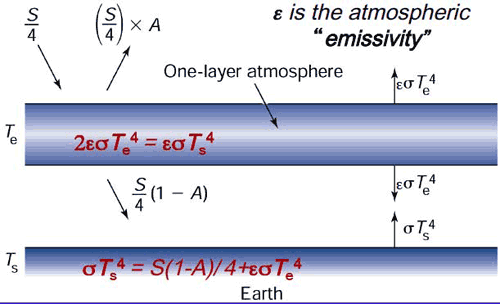Toddsterpatriot
Diamond Member
wasn't me, and you asked, I answered. why do you need to bring in SSDD to our exchange exactly? are you obsessed with him? can't get him out of your head?Sure, 2nd Law of Thermodynamics. Guys name was Clausius I believe.Lucky thing we're applying SB to the surface of the Earth ... you've been told this a dozen times ... we use NS in the atmosphere ...
No....climate science is using the SB law to calculate the radiation from the atmosphere as well......
Here...from Columbia University......Highlighted at step 8
The greenhouse effect.
As described in the notes to lecture 1, when we apply this equation to Earth the calculated temperature we obtain is much lower than the observed temperature. As explained in the notes this is because the Earth's atmosphere contains gases that absorb the longwave radiation emitted from the Earth's surface. Let us now examine what this atmospheric absorption implies.

Figure 2: A plant with an atmosphere containing a single layer of IR absorbing matter.
Consider Figure 2 above. It shows the planet's surface still receiving a solar flux of (1-A) S (accept for reflection, expressed in the albedo A, the solar flux is hardly affected by the presence of the atmosphere because only small segments of the shortwave spectrum are absorbed by its constituents). The planet warms up and emits a flux of longwave (IR) radiation that we will denote by the letter G. In the atmosphere there are gases that absorb longwave radiation. We will consider for a moment that these gases are all arranged in a layer of some thickness above the surface and spread equally over the entire planet. We will also assume that all the longwave radiation is absorbed in that layer. As it absorbs the longwave radiation the layer also warms up and by radiative laws also emits longwave radiation. We will denote this flux by the letter H. Because the layer is elevated from the surface, it emits radiation through both its upper and lower surface in equal amounts. Thus overall the layer emits a total flux of 2H W m-2. Using these considerations we can find if the addition of longwave radiation absorbing gases to the atmosphere changes the equilibrium surface temperature.
In this new situation the outer surface of the absorbing layer becomes the outer surface of the planet, and as described in section 1 above, it must come to radiative balance with the radiation absorbed by the planet. Thus, in radiative balance and following equation (5) above, we have:
(6) H = (1-A) S / 4
where the division by 4 represents the ratio between the effective planetary area for absorption of solar radiation and the planetary area emitting longwave radiation (Figure 1 above).
At the surface, the energy balance is:
(7) G = (1-A) S / 4 + F
This is because all the incoming shortwave radiation, not reflected back to space, is absorbed by the Earth's surface. Substituting for H from equation (6) we get:
(8) G = 2 (1-A) S / 4
The addition of one IR absorbing layer has thus changed the balance of energy at the ground. It now must balance twice as much radiation than before! We can now use the Stefan-Boltzman law to find out the new equilibrium temperature (the one affected by the greenhouse effect) and get:
(9) sTg4 = 2 (1-A) S / 4
Which implies that in the presence of one effective layer of an atmospheric absorbent the temperature ( Tg) is larger than the equivalent temperature ( Te) by a factor of 21/4 (the fourth root of 2 or approximately 1.2).
When this calculation is repeated adding another layer, the temperature at the equilibrium temperature at the ground increases even more. With N layers, equation 9 becomes:
(10) σTg4 = (1+N) (1-A) S / 4
and TG becomes (1+N)1/4 times larger than Te.
As you can see, according to climate science, the so called greenhouse gasses in the atmosphere represent a second absorption layer and according to them, there is now TWICE as much radiation as before...imagine...simple absorption and emission doubles the amount of energy present...That is the nature of the greenhouse effect as described by climate sceince, and as you can see, the SB law is used to calculate the amount of energy radiating from this new absorbing layer in the atmosphere to reach a new equilibrium temperature...
As it absorbs the longwave radiation the layer also warms up and by radiative laws also emits longwave radiation. We will denote this flux by the letter H. Because the layer is elevated from the surface, it emits radiation through both its upper and lower surface in equal amounts.
Do you have any sources that say the cooler atmosphere is prohibited from emitting back toward the warmer surface?
The Clausius Statement: It is impossible to construct a device which operates on a cycle and produces no other effect than the transfer of heat from a cooler body to a hotter body. It is remarkable that the two above statements of the Second Law are in fact equivalent
Sure, 2nd Law of Thermodynamics.
SSDD posted a source that disagreed with the 2nd Law?
wasn't me, and you asked, I answered.
I asked him.
why do you need to bring in SSDD to our exchange exactly?
Why do you need to answer a question to him?
If you want to answer the question to him, provide a source that answers my actual question.
Do you have any sources that say the cooler atmosphere is prohibited from emitting back toward the warmer surface?
The source would have to say, "the cooler atmosphere is prohibited from emitting back toward the warmer surface, because the 2nd Law" or something equivalent.

